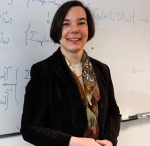Silke BIERMANN

Head of the Department of Physics at Ecole Polytechnique
Professeur at Ecole Polytechnique
Research group : Condensed Matter
Head of the team "Condensed matter" at CPHT
Group Silke Biermann : Electronic Structure Theory
Silke Biermann receives the 2013 ERC Consolidator Grant
| Address | CPHT, Ecole Polytechnique, 91128 Palaiseau cedex, France |
| Phone number |
|
| Contact | firstname.lastname@polytechnique.edu |
| Office | "Aile zéro", Office 1007 |
Research interest
My research is concerned with strong electronic Coulomb interactions in solid state systems. The key questions are: What’s the role of strong Coulomb interactions, and what consequences can they have? How to handle them within solid state theory?
The first question cannot be discussed without mentioning the following points: Metal-insulator transitions Spectral weight transfer from quasi-particle excitations to incoherent contributions Interplay of structural, orbital and spin degrees of freedom in correlated materials Non-local effects of Coulomb correlations During the last 40 years Density Functional Theory (DFT) within the local density approximation (LDA) has revolutionized the field of electronic structure calculations. Still, the materials I am particularly interested in are precisely those for which this theory is not sufficient. In strongly correlated systems Coulomb many-body effects cannot be expressed within an effective single-particle theory; to calculate dynamical correlations Dynamical Mean Field Theory (DMFT) is a useful tool. Combining DFT and DMFT (which leads to the so-called "LDA+DMFT" method) nowadays allows to calculate the electronic structure of strongly correlated materials (nearly) from first principles (i.e. without adjustable parameters).
Relevant methodological questions include: Developments within LDA+DMFT, e.g. concerning impurity model solvers, basis sets Cluster extensions of DMFT Some fundamental questions (e.g.: What’s U in a solid? ) Developments of alternative (first principles) approaches (the word "nearly" is missing now!), such as GW+DMFT
Materials that are good test cases are e.g. the following: transition metals their oxides (e.g. VO2, vanadates, titanates) and sulfides lanthanides and actinides quasi-1d systems Recently, I found myself also doing quite a lot of work on iron-oxypnictides and related compounds, such as LaFeAsO, FeSe, or BaFe2As2.
Recent Publications
Stepanov EA, Nomura Y, Lichtenstein AI, Biermann S.
Orbital Isotropy of Magnetic Fluctuations in Correlated Electron Materials Induced by Hund's Exchange Coupling.
Physical Review Letters. 2021;127(20):207205.
DOI: 10.1103/PhysRevLett.127.207205.
Thees M, Lee M-H, Bouwmeester RL, Rezende-Gonçalves PH, David E, Zimmers A, Fortuna F, Frantzeskakis E, Vargas NM, Kalcheim Y, Fèvre PL, Horiba K, Kumigashira H, Biermann S, Trastoy J, Rozenberg MJ, Schuller IK, Santander-Syro AF.
Imaging the itinerant-to-localized transmutation of electrons across the metal-to-insulator transition in V2O3.
Science Advances. 2021;7(45):eabj1164.
DOI: 10.1126/sciadv.abj1164.
Galler A, Boust J, Demourgues A, Biermann S, Pourovskii LV.
Correlated electronic structure and optical response of rare-earth based semiconductors.
Physical Review B. 2021;103(24):L241105.
DOI: 10.1103/PhysRevB.103.L241105.
Galler A, Ener S, Maccari F, Dirba, I, Skokov KP, Gutfleisch O, Biermann S, Pourovskii LV.
Intrinsically weak magnetic anisotropy of cerium in potential hard-magnetic intermetallics.
npj Quantum Materials. 2021;6(1):2.
DOI: 10.1038/s41535-020-00301-6
Leonov I, Biermann S.
Electronic correlations at paramagnetic (001) and (110) NiO surfaces: Charge-transfer and Mott-Hubbard-type gaps at the surface and subsurface of (110) NiO.
Physical Review B. 2021;103(16):165108.
DOI: 10.1103/PhysRevB.103.165108.
Steinbauer J, Biermann S.
Intershell interactions in correlated materials: A slave-rotor approach.
Physical Review B. 2021;103(19):195109.
DOI: 10.1103/PhysRevB.103.195109.
Curriculum Vitae
Degrees
Ph.D., Physics, University of Cologne, Germany, 2000
Diploma degree, Physics, University of Cologne, Germany, 1996
Maîtrise, Physics, Magistère Interuniversitaire de Physique des Universités Paris VI, VII, XI, XIII et de l’École Normale Supérieure Paris, France, 1994
Prediploma degrees, Physics and Mathematics, University of Cologne, Germany, 1993
Research
Since September 2003 Professeur Chargée de Cours ("Associate professor") at École Polytechnique, France Affiliation: Centre de Physique Théorique, École Polytechnique, Palaiseau, France. September 2000 - August 2003 Postdoctoral fellow/CNRS associate researcher at Laboratoire de Physique des Solides Université Paris Sud and Laboratoire de Physique Théorique de l’Ecole Normale Supérieure Paris, France April 1997 - August 2000 Ph.D. student at Juelich Research Centre, Germany July 1996 - March 1997 Visiting scholar at Texas A&M University, Texas, USA Organisation of conferences and schools
Workshop "Electronic Structure of Correlated Materials" and Mid-Term Review of the RTN "f-Electron Materials", Paris, 2004
PhotoWorkshop on Ab Initio Methods for Correlated Spintronics Materials, Mont Saint Odile, 2004
School on "Electronic Structure Calculations and Correlated Materials", Les Houches, 2006.
Links
LPS Orsay
LPT ENS
Studienstiftung des deutschen Volkes
Condmat-ArXiv
PMC
